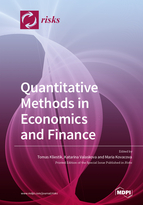Quantitative Methods in Economics and Finance
A special issue of Risks (ISSN 2227-9091).
Deadline for manuscript submissions: closed (30 September 2020) | Viewed by 31614
Special Issue Editors
Interests: financial management; behavioral finance; econometric models; credit risk
Special Issues, Collections and Topics in MDPI journals
Interests: international financial markets; behavioural decision making; risk modelling; risk analysis; financial statistics
Special Issues, Collections and Topics in MDPI journals
Interests: financial markets; financial econometrics; bankruptcy prediction; credit risk
Special Issues, Collections and Topics in MDPI journals
Special Issue Information
Dear Colleagues,
The beginnings of quantitative methods and mathematical modeling in economics and finance can be traced back to the early stages of the development of classical political economy and are associated with names such as William Petty (1623–1687), Francois Quesnay (1694–1774), Léon Walras (1834–1910), Leonard Euler (1707–1783), Vilfredo Pareto (1848–1923), and many others. After the First World War, we can see a massive expansion of quantitative methods, both theoretical and practical. The exception was neither economics nor finance. An important milestone in this development was the year 1931, when the Econometric Society was founded and started to issue the Econometrica journal on a regular base. This helped to establish a new scientific branch of Econometrics, which considers the mathematical description and statistical verification of economic relations as its main content and, in a broader sense, also the implementation of mathematical methods into economics. The importance of quantitative methods in economics is clearly evident by the number of Nobel Prizes awarded for economics, where mathematical economists form a significant majority of laureates. For the thematic focus of this Special Issue, allow us to mention the most important ones: Leonid Vitalievič Kantorovič, James Tobin, Franco Modigliani, Harry M. Markowitz, Merton Miller, William F. Sharpe, John Forbes Nash, John C. Harsanyi, Robert Merton, Myron Scholes, Robert F. Engle, Clive W. J. Granger, Robert J. Aumann, Leonid Hurwicz a Eugene Fama.
We invite both theoretical and empirical contributions, which will be an important contribution to the development of the subject issue. We would like to thank potential authors for their efforts and wish plenty of success in the theory and practice of quantitative methods and mathematical modeling in economics and finance.
Prof. Dr. Tomas Kliestik
Dr. Katarina Valaskova
Dr. Maria Kovacova
Guest Editors
Manuscript Submission Information
Manuscripts should be submitted online at www.mdpi.com by registering and logging in to this website. Once you are registered, click here to go to the submission form. Manuscripts can be submitted until the deadline. All submissions that pass pre-check are peer-reviewed. Accepted papers will be published continuously in the journal (as soon as accepted) and will be listed together on the special issue website. Research articles, review articles as well as short communications are invited. For planned papers, a title and short abstract (about 100 words) can be sent to the Editorial Office for announcement on this website.
Submitted manuscripts should not have been published previously, nor be under consideration for publication elsewhere (except conference proceedings papers). All manuscripts are thoroughly refereed through a single-blind peer-review process. A guide for authors and other relevant information for submission of manuscripts is available on the Instructions for Authors page. Risks is an international peer-reviewed open access monthly journal published by MDPI.
Please visit the Instructions for Authors page before submitting a manuscript. The Article Processing Charge (APC) for publication in this open access journal is 1800 CHF (Swiss Francs). Submitted papers should be well formatted and use good English. Authors may use MDPI's English editing service prior to publication or during author revisions.
Keywords
- Risk analysis and modeling in economics and finance
- Value at risk and conditional value at risk
- CreditMertics and CorporateMetrics
- Financial econometrics
- Volatility models
- Risk of corporate bankruptcy prediction
- Structural credit risk modeling
- Reduced-form credit risk modeling
- Earnings management








